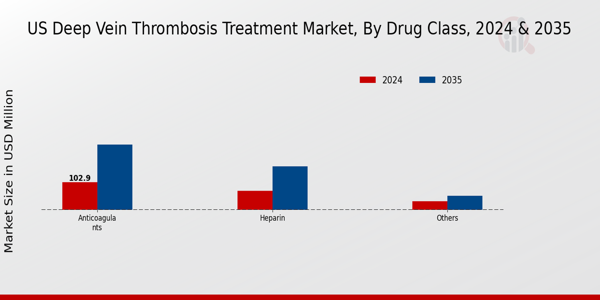US Deep Vein Thrombosis Treatment Market Overview
As per MRFR analysis, the US Deep Vein Thrombosis Treatment Market Size was estimated at 191.44 (USD Million) in 2023. The US Deep Vein Thrombosis Treatment Market Industry is expected to grow from 205.8 (USD Million) in 2024 to 458.27 (USD Million) by 2035. The US Deep Vein Thrombosis Treatment Market CAGR (growth rate) is expected to be around 7.549% during the forecast period (2025 - 2035).
Key US Deep Vein Thrombosis Treatment Market Trends Highlighted
The US Deep Vein Thrombosis (DVT) Treatment Market is experiencing notable trends driven largely by the increasing prevalence of conditions that lead to thrombosis, such as obesity, diabetes, and an aging population.
As healthcare providers emphasize preventive measures, there has been a significant shift towards the use of anticoagulants and new oral therapies for effective management of DVT, driven by the quest for better patient outcomes. The rising awareness of DVT among healthcare professionals and patients has fueled the demand for innovative treatment solutions, with significant interest in telemedicine and remote monitoring, especially in the aftermath of the COVID-19 pandemic.
Venturing into the field of personalized medicine and novel therapeutic agents that reduce side effects while improving treatment efficacy presents unparalleled opportunities. With the recent technological advancements, companies began working on new drug delivery systems, which leads to better patient compliance.
Additionally, government programs focused on increasing vascular health awareness and prevention are also positively impacting the market. There are also reports indicating increased funding towards the research and development of DVT treatments in the US, which incorporate artificial intelligence and machine learning to identify patients with a high risk of thrombosis.
Collaborations between healthcare systems and research institutions are becoming more common to drive innovation and better understand treatment pathways. Overall, the evolution of treatment protocols, coupled with strategic advancements and regulatory support, is shaping the future of the DVT treatment landscape in the US significantly.

Source: Primary Research, Secondary Research, MRFR Database, and Analyst Review
US Deep Vein Thrombosis Treatment Market Drivers
Increasing Incidence of Deep Vein Thrombosis Cases
The United States has been witnessing a significant rise in the incidence of Deep Vein Thrombosis (DVT) cases, largely attributed to an aging population and lifestyle factors such as obesity and sedentary behavior. According to the Centers for Disease Control and Prevention (CDC), approximately 900,000 Americans are affected by DVT annually, with a concern that the prevalence may double in the next decade. The increase in patients diagnosed with DVT translates directly into a growing demand for effective treatment options in the US Deep Vein Thrombosis Treatment Market Industry.
Furthermore, leading health organizations such as the American Heart Association are actively promoting awareness and screening for DVT, which encourages early diagnosis and treatment, providing more opportunities for healthcare providers involved in DVT management. This results in a robust growth trajectory for the market.
Advancements in Medical Technology
Recent advancements in medical technology, including the development of innovative anticoagulants and minimally invasive procedures for treating DVT, have significantly contributed to the growth of the US Deep Vein Thrombosis Treatment Market Industry. Advances such as catheter-directed thrombolysis and novel oral anticoagulants have been shown to improve patient outcomes and reduce recovery times. The American College of Cardiology has reported an increase in the utilization of these advanced therapies, leading to better management of DVT cases.
As healthcare providers adopt these technologies, the market is expected to expand, catering to the demand for more efficient and effective treatment solutions across the United States.
Government Initiatives and Policy Reforms
Government initiatives aimed at improving vascular health and tackling cardiovascular diseases play a critical role in the US Deep Vein Thrombosis Treatment Market Industry. The US government has instituted numerous programs focused on increasing awareness and funding for related health conditions. For instance, the National Heart, Lung, and Blood Institute conducts public outreach campaigns regarding the prevention of DVT, emphasizing the importance of early detection and appropriate management.
These initiatives not only raise awareness but also drive healthcare investments and foster an environment conducive to the development and introduction of new treatment modalities in the market. As policies evolve to improve healthcare access and education regarding DVT, market growth is anticipated to accelerate.
US Deep Vein Thrombosis Treatment Market Segment Insights
Deep Vein Thrombosis Treatment Market Drug Class Insights
The US Deep Vein Thrombosis Treatment Market, particularly within the Drug Class segment, represents a significant area of focus in the healthcare landscape, primarily due to the increasing prevalence of deep vein thrombosis (DVT) conditions across the country. DVT often manifests as a serious complication, demanding the attention of healthcare professionals, which has led to the development and utilization of various drug therapies aimed at effectively managing this condition.
Among these therapies, Anticoagulants emerge as a critical element in the treatment protocol, serving to prevent clot formation and reduce the risk of morbidity and mortality associated with DVT. The importance of this drug class is underscored by its adoption in both inpatient and outpatient settings, reflecting a growing recognition of the need for effective DVT management strategies in the US healthcare system.
Heparin, another vital component of the Drug Class segment, has been widely used for decades and remains a cornerstone in the management of DVT. Its rapid action and ease of administration make it a preferred choice for acute care situations, while continuous research into its application is paving the way for innovative uses within the thrombosis treatment spectrum.
The role of Heparin extends beyond mere treatment; it embodies the advancements made in pharmacological strategies aimed at combating thrombotic events. Additionally, the presence of other emerging therapies in the Drug Class segment highlights the dynamic nature of DVT treatment methodologies, embodying ongoing innovations and avenues for enhanced patient care, thereby creating new opportunities for healthcare practitioners.
Market trends indicate a shift towards more targeted therapies and personalized treatment plans as advancements in medical technology continue to evolve. This trend is largely influenced by the increasing understanding of individual risk factors associated with thrombotic events, driving the demand for more tailored approaches. The integration of artificial intelligence and machine learning in predictive analytics is poised to provide insights that will further enhance the efficacy of treatments within the Drug Class segment.
Moreover, the rising incidence of risk factors such as obesity, sedentary lifestyles, and medical conditions like cancer and heart disease is predicted to contribute to a sustained demand for DVT treatment across the United States. This raises the significance of continued research and development initiatives aimed at furthering the understanding and effectiveness of existing drug therapies as well as introducing novel therapies to the market.
The ongoing opioid crisis and rising healthcare costs challenge the industry as healthcare providers seek effective yet economically viable treatment options for DVT. As a result, the Drug Class segment must navigate these challenges while fulfilling the evolving needs of both healthcare professionals and patients alike.
The need for cost-effective solutions in managing DVT is imperative, underscoring the opportunities for pharmaceutical companies to innovate and address these complexities effectively. Understanding the nuances of each drug type within the Drug Class segment will be essential for stakeholders aiming to secure a foothold in the US Deep Vein Thrombosis Treatment Market, driving future growth and strategic investments.

Source: Primary Research, Secondary Research, MRFR Database, and Analyst Review
Deep Vein Thrombosis Treatment Market Treatment Insights
The US Deep Vein Thrombosis Treatment Market encompasses a range of therapeutic options with a significant focus on Treatment, which plays a critical role in managing this condition. Within this segment, Surgery is vital, offering solutions for severe cases where other treatments may be ineffective, thus highlighting its importance for patient outcomes. Drugs are also a key component, providing patients with anticoagulants and other medications that are necessary for prevention and management, making it a dominant segment in terms of market presence.
Additionally, other approaches, which might include lifestyle interventions and mechanical devices, are gaining attention as adjuncts to traditional treatments. Overall, the Treatment segment reflects a multi-faceted strategy aimed at reducing complications associated with deep vein thrombosis.
As healthcare providers emphasize personalized medicine and patient-centered care, the demand for innovative treatments is expected to continue growing, significantly contributing to the US Deep Vein Thrombosis Treatment Market revenue. The increasing prevalence of risk factors such as immobility, obesity, and recent surgical procedures supports the market dynamics, pushing for advancements and expanding the range of available treatment options.
Deep Vein Thrombosis Treatment Market Mode Of Administration Insights
The Mode Of Administration segment of the US Deep Vein Thrombosis Treatment Market showcases substantial diversity, encompassing various delivery methods such as injectable, oral, and others. Injectable treatments are often preferred for their rapid onset of action and are vital in acute settings where immediate therapeutic effects are crucial. The oral administration route caters to patients seeking convenience and ease of use, aligning with trends toward patient-centric care. Additionally, the 'others' category includes emerging and alternative methods that may enhance the treatment experience for specific patient demographics.
The importance of these modes is evident as they directly impact patient adherence and overall treatment efficacy, ensuring a tailored approach to Deep Vein Thrombosis management. As healthcare continues to evolve, innovations in drug delivery systems will likely further shape this segment, responding to the rising prevalence of venous thromboembolism in the US population. With demographic trends indicating an increase in risk factors associated with Deep Vein Thrombosis, strategic advancements in the Mode of Administration are expected to play a pivotal role in optimizing therapeutic outcomes in the coming years.
Deep Vein Thrombosis Treatment Market Distribution Channel Insights
The Distribution Channel segment of the US Deep Vein Thrombosis Treatment Market plays a crucial role in ensuring patients receive timely access to necessary treatments. Hospital Pharmacies are vital as they are often the first point of care, providing specialized medication management for inpatients receiving acute treatment.
Retail Pharmacies offer convenience and accessibility for outpatient services, allowing patients to obtain their prescriptions readily, which is significant in a country where convenience often drives patient compliance. Online Pharmacies have gained traction in recent years, especially due to increased digital health adoption and the pandemic, providing an alternative channel that enhances patient access and privacy.
The market's dynamics are influenced by healthcare trends such as the growing awareness of deep vein thrombosis, the importance of preventive measures, and an expanding patient population, driving demand across all distribution channels. Rising e-commerce trends and technological advancements in online pharmacy services are set to further fuel growth in this segment, emphasizing the multi-faceted approach needed to effectively address the needs of patients with deep vein thrombosis.
Deep Vein Thrombosis Treatment Market End-User Insights
The US Deep Vein Thrombosis Treatment Market showcases a diverse range of End-User segments, including Hospitals, Homecare, Specialty Clinics, and Others, reflecting varying treatment preferences and healthcare delivery models across the country.
Hospitals are crucial as they provide immediate and comprehensive treatment options, playing a significant role in managing acute cases of Deep Vein Thrombosis. Homecare is gaining traction due to increased patient comfort, allowing individuals to receive care in familiar settings, which positively affects recovery rates and patient satisfaction.
Specialty Clinics offer tailored treatment plans by focusing on specific patient needs, often providing advanced technology and specialized care, thus enhancing patient outcomes. Furthermore, the "Others" category encompasses diverse alternatives, each contributing to the overall landscape of DVT treatment options available in the US.
The growing awareness of Deep Vein Thrombosis and its implications promotes investment in these areas, which facilitates market growth. As the prevalence of risk factors, such as prolonged immobility and age, continues to rise, the demand across all End-User segments is expected to evolve, reflecting an increasing need for effective treatment solutions in the healthcare system.
US Deep Vein Thrombosis Treatment Market Key Players and Competitive Insights
The US Deep Vein Thrombosis Treatment Market is characterized by a dynamic and competitive landscape driven by the increasing prevalence of chronic conditions that lead to DVT, such as obesity, cancer, and prolonged immobility among patients. Various pharmaceutical companies and healthcare providers are focusing on advanced therapeutic solutions and innovative drug formulations to enhance patient outcomes.
The market is primarily segmented into medication types, including anticoagulants and thrombolytics, and is influenced by the evolving treatment guidelines, increased patient awareness, and the growing burden of cardiovascular diseases. As the healthcare industry emphasizes value-based care, competition among key players intensifies, leading to the development of novel treatment options, investment in research and development, and strategic collaborations to capture market share.
Merck has a strong foothold in the US Deep Vein Thrombosis Treatment Market, primarily recognized for its widely prescribed anticoagulant therapies. The company has established itself as a leader through a robust pipeline of innovative drug formulations that address critical aspects of DVT management. Merck's strengths lie in its extensive research capabilities and the high safety and efficacy profile of its products.
The firm has effectively leveraged partnerships and collaborations to enhance its market presence, engaging in initiatives that focus on clinical evidence supporting its treatment options. This approach has not only strengthened Merck's position within the DVT segment but has also facilitated deeper penetration into various healthcare institutions across the US, allowing for better accessibility of its therapies to healthcare professionals and patients alike.
Sanofi is a prominent player in the US Deep Vein Thrombosis Treatment Market, known for its effective anticoagulant options designed to prevent and treat DVT. The company has a strong market presence bolstered by its commitment to research and innovation aimed at developing therapies that cater specifically to the needs of DVT patients. One of Sanofi's key strengths is its established product portfolio, which includes well-recognized medications that have proven to be effective in managing DVT and its complications.
Furthermore, Sanofi has been active in mergers and acquisitions, strategically acquiring companies and products that enhance its therapeutic offerings within the US market. These strategic moves not only expand its product lineup but also increase its competitiveness by providing comprehensive solutions for DVT treatment, underlining the company’s dedication to improving patient outcomes and solidifying its leadership status within this therapeutic area.
Key Companies in the US Deep Vein Thrombosis Treatment Market Include
US Deep Vein Thrombosis Treatment Market Industry Developments
The US Deep Vein Thrombosis Treatment Market has recently seen significant developments, including ongoing advancements in novel anticoagulant therapies. Companies such as Merck and Pfizer are focusing on Research and Development to enhance therapeutic options for patients. In terms of market dynamics, the incorporation of artificial intelligence in patient care is gaining traction, influencing treatment protocols and outcomes.
Notably, Bayer had completed the acquisition of a biotechnology company focused on thromboembolic disorders in August 2023, which was a strategic move to bolster its product offerings in this domain. Furthermore, Johnson and Johnson reported an increase in their market share owing to the successful launch of a new drug for DVT management last year, aiding in the expansion of their portfolio.
Over the past few years, the overall market value of the US Deep Vein Thrombosis Treatment Market has shown an upward trajectory, especially with the approval of additional drugs by the FDA in early 2022. This trend indicates a robust pipeline and a heightened focus on improving patient outcomes within the therapeutic landscape.
Deep Vein Thrombosis Treatment Market Segmentation Insights
-
Deep Vein Thrombosis Treatment Market Drug Class Outlook
- Heparin
- Others
-
Deep Vein Thrombosis Treatment Market Treatment Outlook
- Drugs
- Others
-
Deep Vein Thrombosis Treatment Market Mode Of Administration Outlook
- Oral
- Others
-
Deep Vein Thrombosis Treatment Market Distribution Channel Outlook
- Retail Pharmacies
- Online Pharmacies
| Report Attribute/Metric |
Details |
| Market Size 2023 |
191.44 (USD Million) |
| Market Size 2024 |
205.8 (USD Million) |
| Market Size 2035 |
458.27 (USD Million) |
| Compound Annual Growth Rate (CAGR) |
7.549% (2025 - 2035) |
| Report Coverage |
Revenue Forecast, Competitive Landscape, Growth Factors, and Trends |
| Base Year |
2024 |
| Market Forecast Period |
2025 - 2035 |
| Historical Data |
2019 - 2024 |
| Market Forecast Units |
USD Million |
| Key Companies Profiled |
Merck, Sanofi, Bayer, AbbVie, Novo Nordisk, Pfizer, Bristol Myers Squibb, AstraZeneca, Johnson & Johnson, Novartis, Roche, Eli Lilly, GSK, Amgen, Mylan |
| Segments Covered |
Drug Class, Treatment, Mode Of Administration, Distribution Channel, End-User |
| Key Market Opportunities |
Increasing awareness campaigns, Advancements in catheter-based therapies, Rising demand for anticoagulant drugs, Growth in home healthcare services, Development of personalized treatment options |
| Key Market Dynamics |
Increasing prevalence of DVT, Technological advancements in treatments, Growing geriatric population, Rising awareness and screening, High healthcare expenditure |
| Countries Covered |
US |
Frequently Asked Questions (FAQ) :
The US Deep Vein Thrombosis Treatment Market is expected to be valued at 205.8 million USD in 2024.
By 2035, the market value of the US Deep Vein Thrombosis Treatment is projected to reach 458.27 million USD.
The expected CAGR for the US Deep Vein Thrombosis Treatment Market from 2025 to 2035 is 7.549%.
Anticoagulants are expected to dominate the US Deep Vein Thrombosis Treatment Market with a value of 102.9 million USD in 2024.
The market value for Heparin in the US Deep Vein Thrombosis Treatment Market is anticipated to be 162.35 million USD by 2035.
Major players in the US Deep Vein Thrombosis Treatment Market include Merck, Sanofi, Bayer, and AbbVie, among others.
The market value for Other treatments in the US Deep Vein Thrombosis Treatment Market is projected to be 32.4 million USD in 2024.
The market presents opportunities driven by advancements in drug therapies and increasing awareness of DVT management.
Challenges faced by the market include regulatory hurdles and competition among existing drug therapies.
The US Deep Vein Thrombosis Treatment Market is expected to evolve significantly, with an increase to 458.27 million USD by 2035.
















